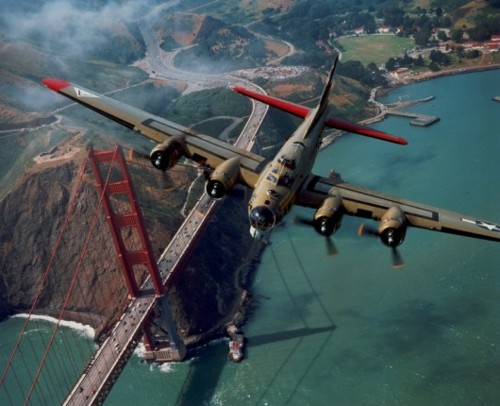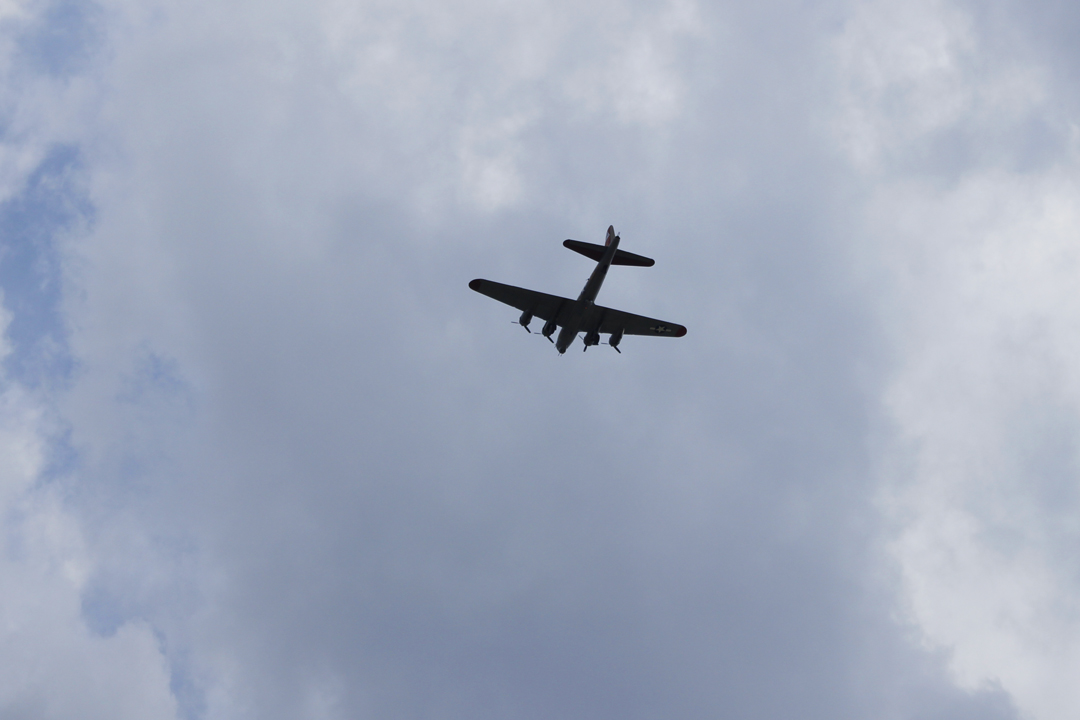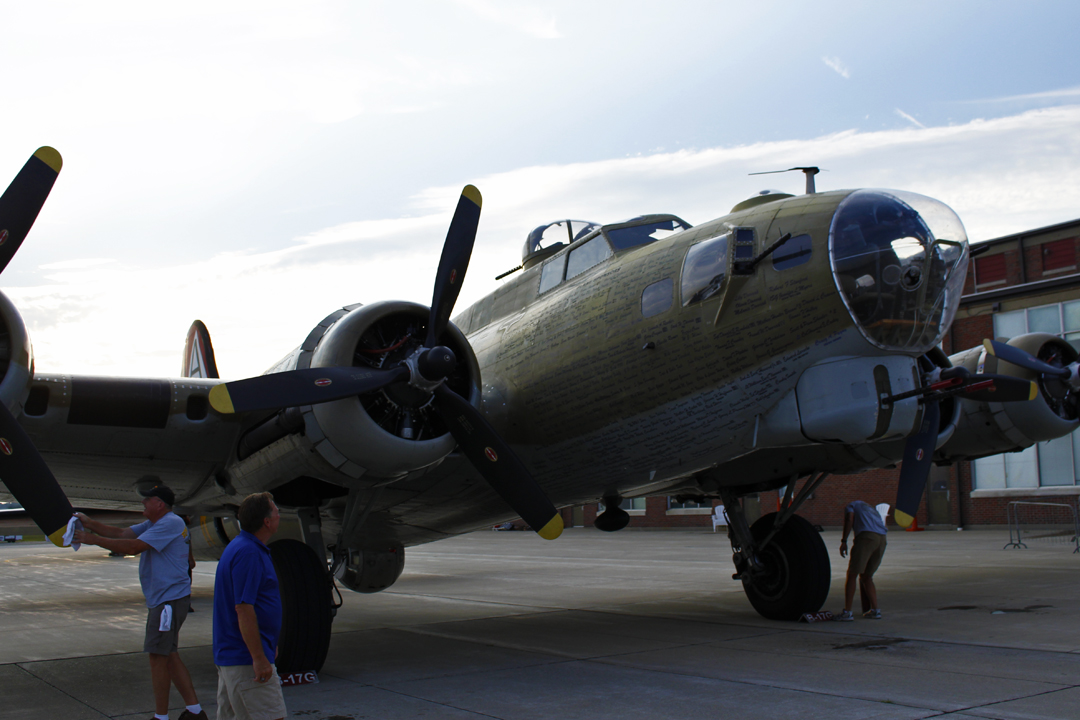
I came across this photo (above) of Nine-0-Nine a couple of years ago, on some 'blog page or other, and smiled to see a B-17 flying. That it was flying over the Golden Gate Bridge was a delightful bonus. I didn't know at the time what name she was flying, nor was there a photographer noted, alas. This image can now be had as a wallpaper for your monitor, but I was told Wednesday morning that shots like this are arranged between the Collings Foundation and photographers who can take the time to go up in private planes during moves between tour stops. So someone should have title to this, and likely Collings as well. So to you, great un-named lensman, my hat's off! Given the opportunity, I'll follow your footsteps into some chase plane.
On the drive home on Tuesday evening, I'll admit I was in a bit of a fog. All I could think was "wow" for having been for a flight in a B-17. I also had a pretty good idea that I wasn't going to be done with the whole thing unless I tried to photograph the aircraft as they left town.
I went back to the Purdue terminal on Wednesday just before Noon to ask when the planes were flying out. The next stop on the tour was in the Akron, Ohio, area at two o'clock that afternoon, so they should have gone up about twelve-thirty. That gave me enough time to get back to the theatre building, get some water and my camera and head up on the roof. I thought the vantage would garner a nice wide view of the planes leaving, and this did prove to be the case. But I guess that pesky No 3 on Witchcraft delayed the operation, because it was more like one-thirty before anything other than Purdue's "practice planes" left the ground.
 web.jpg?1498703339184)
I watched the "practice planes" take off, land, touch-and-go, and kept I thinking "well, it should be soon" but after almost an hour and a half I was starting to think maybe the tour had got off before I got back under the sky. When Tondelayo appeared, I did get to see it pass a considerable distance before it disappeared to the east.
 web.jpg?1498703339217)
 web.jpg?1498703340377)
Several of Purdue's planes took a flight path that went pretty close to overhead as they crossed the campus; when Toulouse Nuts left the ground, she banked, and I wondered if she would follow a similar path.
 web.jpg?1498703340240)
 web.jpg?1498703345613)
 web.jpg?1498703345945)
She did. But as before, 51's don't wait for you, especially when they're running late for their next appointment. The near over-head shot below isn't quite in focus, but you get the idea.
 web.jpg?1498703346001)
At what speed do 51's cruise? Fast. And loud. A few seconds after this shot, she was gone into the partly cloudy blue.
I had seen the planes taxi away from the terminal, and Witchcraft was not among them. So Nine-0-Nine would be next. Sorry to say I didn't go back to find out the fate of the 24, but it was not in the flight out at this time.
 web.jpg?1498703346740)
Was this what I was waiting for? Well - yes, yes it was. I would have stuck around had the 17 gone up first, but I guess this was the finale. It's - funny? strange? nostalgic? - how things can become iconic once time enough has passed, once they have become rare, once their original users get old and look back at ago with some mental distance. Following the conclusion of hostilities, the majority of the aircraft that had lately been so intrinsic to the prosecution of strategic aims were relegated to the proverbial and literal scrap yard, sold for the metal that they were built from.
 web.jpg?1498703344860)
There has been a fair amount of opinion expressed concerning the changing attitudes about "what it means to be an American" in the years following the war, as well as cultural criticism of the "look" of consumer products, industrial design, architecture, what-have-you post World War Two, . The usual idea has it that the emphasis on science and scientific progress, the socio-economic movements of the 20's and 30's, and even the styling of American Moderne, were all part-and-parcel of the sweep of history that led directly to the outbreak of the war; once the war had been concluded, America simply wanted to "move on," and "move up." Cities that had bulged and sprawled during "the war effort" were seen as places to be left behind for cleaner greener pastures where a home could be owned, influences of the Old World were downplayed or denigrated, and with a rise in income for a significant slice of the population, the nation became one of consumers. Those consumers wanted new stuff, and the physical embodiment of "moving on" was as important to the designers, architects, and especially to ad men, as the GI Bill, Levittown, and low interest rates were to the burgeoning middle class. The moderne and industrial styles were jettisoned along with many of the ideas that spurred them as being too much a part of those sorry years that brought us Hitler and Tojo. And Stalin, who had been an ally, but was now the menace on the other side of the Iron Curtain. The planes, trucks, tanks, and jeeps were left behind: their symbolic aspects were better if relegated to the movies where, in the cool of air conditioning, you could root for the good guys in dirty olive drab, and boo those nasty Axis soldiers, and then forget about it (or at least push it aside) again when the credits rolled.
 web.jpg?1498703346088)
That the aircraft lately flown during the war would be reduced to scrap metal was likely the last thing on anyone's mind circa 1950. If any of the veterans did bother to consider what happened to their planes, I wonder if they would have had any pangs to know that the 17 or 24 or 25 or 51 that had carried them into the skies over Europe (or Okinawa, or Japan, or Burma) had been reduced? Or would they have simply muttered "fuck it" (though not with the wife around, surely) and gone about their business? "Good riddance," perhaps. "Who needs 'em around now?" maybe. Of course the conclusion of one conflict hardly put paid to the idea of war. And years, decades, later with the loosening of thoughts and mayhap a few tongues, the reflection on what those planes might stand in for crept into people's consciousness. Nostalgia? Some. Contrasting "what we did" with "this younger generation?" That, too. Symbols became important. Something you could point to and say "I did..." except that there weren't a lot of things left that you could point to. The world had moved on, say sorry.
 web.jpg?1498703348289)
Nine-0-Nine winging its way across Lafayette.
But some remain, and sometimes they may visit your neighborhood. If they do, go see them, and think about what they were built for. Marvel at their technical brilliance (or lack, mayhap) - that these planes are 70+ years old and still they can be repaired and flown is testament to the folk with the slide rules and a lot of drafting paper (back when draftings were done on paper with a T-square and a triangle) as well as the thousands of man-hours it took to do the restoration and get them back up in the air. Think on the thousands of man-hours spent by the crews who flew in the cold high altitudes, waiting for the anti-aircraft fire, the Luftwaffe, and praying that they'll get back one more time. Think that for the ten B-17's that still fly, there were so many that didn't make it back, and for every one of those, ten men would be missing from the aerodrome, and many of their families would be getting that telegram from the War Department. Remember, too, that we weren't the only people who lost family and friends when those birds flew. The Army Air Forces flew hundreds of missions, and the bombers dropped thousands of tons of ordnance. Everyone loses something when the fire comes.

Yeah, that's a lot riding a few flying antiques, isn't it? Well, so be it. The Collings Foundation's stated purpose for incorporation is "...to organize and support 'living history' events that enable Americans to learn more about their heritage through direct participation." Collings isn't the only organization that flies B-17's and other war birds, so if you get the chance, do a little "direct participation:" put your hands on a B-17 or a B-24 or a P-51 and remember.

The Collings Foundation of Stow, MA, is incorporated as a 501c-3 non-profit educational organization. In addition to touring events like Wings of Freedom, they have amassed a collection of historic vehicles, both aircraft and automobile, that represent some of the earliest examples from the late 1800's and early 1900's, to the later ones from the 1970's. Under the foundation's oversight curators, volunteers and professional organizations have worked to restore these to their best presentation.
Information regarding the aircraft on the Tour can be found on their website.
Additional information can also be found on (yes) wikipedia. The entry for Nine-0-Nine covers both the original bird and the Collings 17 pictured here. The general information regarding the B-17 is also a good introduction to the iconic aircraft. Similarly, pages for the B-24, the B-25, and the P-51 are also nice introductions to these planes, including "notable" information, like Robert Altman having been a B-24 co-pilot in the Pacific Theater.
FRIDAY: flying out
